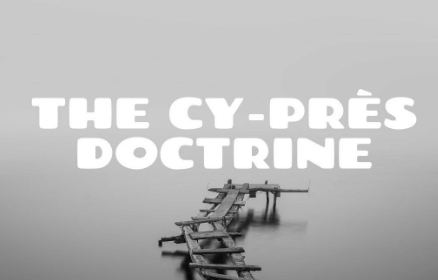Doctrine of Cy pres - CLAT PDF Download
| Table of contents |

|
| Introduction |

|
| Doctrine of Cy Pres under the Civil Procedure Code (CPC) |

|
| Section 92(3) of the CPC |

|
| Landmark Judgments on the Doctrine of Cy Pres |

|
Introduction
The term cy pres originates from the Norman French phrase "cy pres comme possible," meaning "as near as possible." The doctrine of cy pres enables courts to modify or reinterpret the terms of a charitable trust when it becomes impossible or impractical to fulfill the trust's original intent.

Doctrine of Cy Pres under the Civil Procedure Code (CPC)
Section 92(3) of the Civil Procedure Code outlines the circumstances under which a court may alter the purposes of a charitable or religious trust. Under this provision, courts can redirect the property or income of such trusts to purposes that align as closely as possible with the trust's original intent. This ensures the trust’s spirit is preserved, even if the original objectives cannot be wholly or partially achieved due to reasons such as:
- Fulfillment of the original purpose by other means.
- The purpose becoming obsolete, harmful, or no longer charitable.
- Legal, practical, or geographic constraints rendering the original purpose unattainable.
By invoking the cy pres doctrine, courts maintain the trust's overall charitable or religious intent while adapting its implementation to changing circumstances.
Section 92(3) of the CPC
Under this section, courts may modify a trust's purposes and apply the property or income cy pres in the following scenarios:
Fulfillment or Impossibility:
- The original purpose has been achieved as far as possible.
- The purpose cannot be implemented at all or in accordance with the trust's terms or spirit.
Partial Application:
- The original purposes apply to only a portion of the available property.
Combined Use:
- The trust property, alongside similar properties, can be more effectively applied to a different, yet related, purpose.
Geographical Changes:
- The original purpose references a region that has ceased to function as a relevant unit for that purpose.
Inadequacy or Obsolescence:
- The original purpose has been met by other means.
- It is no longer useful, charitable, or beneficial to the community.
- It is unsuitable or ineffective for using the available property.
In all cases, courts ensure the revised application aligns as closely as possible with the trust’s original intent and spirit.
Landmark Judgments on the Doctrine of Cy Pres
Ratilal v. State of Bombay (1954):
- The Supreme Court addressed the application of the cy pres doctrine in this case, ensuring the objectives of charitable trusts were preserved despite restrictions under the Bombay Public Trusts Act, 1950. The Court emphasized that when a charitable trust's specific purpose fails or becomes impractical, courts may redirect its funds towards a similar charitable goal aligned with the trust's general intent.
N.S. Rajabathar Mudaliar v. M.S. Vadivelu Mudaliar & Ors. (1970):
- Here, the Supreme Court applied the cy pres doctrine to redirect trust funds when the original purposes became unattainable.
Abid Hatim Merchant v. Janab Salebhai Saheb Shaifuddin & Ors. (2000):
The Supreme Court, referencing Halsbury's Laws of England, highlighted key principles of the cy pres doctrine:
- Courts administer charitable trusts to align with the donor's general charitable intent, even if the specific mode of application fails.
- The donor’s intentions must be followed as closely as possible, favoring objects and methods nearest to their original wishes.
- In cases where no close alternative exists, the property may still be redirected to charitable uses consistent with the trust's overarching purpose.
FAQs on Doctrine of Cy pres - CLAT
| 1. What is the Doctrine of Cy pres in the context of law? |  |
| 2. How does the Doctrine of Cy pres apply in charitable trusts? |  |
| 3. What are the limitations of the Doctrine of Cy pres? |  |
| 4. How does the Doctrine of Cy pres differ from the Doctrine of Restraint of Alienation? |  |
| 5. Can individuals challenge the application of the Doctrine of Cy pres in court? |  |


















